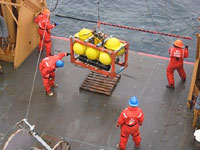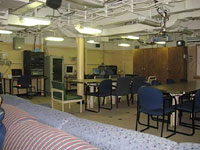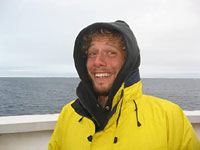

 | |||||||||||||||||
|
|
Journals 2008/2009Steve Howard
August 14, 2008 I had an early morning, getting up at 4am to watch Ethan Roth, a graduate student from Scripps Institution of Oceanography in San Diego, retrieve two of his HARP devices. These two HARP acoustic receivers (HARP stands for High Frequency Acoustic Recording Packages) were deployed out here one year ago and have been collecting background acoustic noise in the region, including vocalizations from marine mammals such as whales and seals. Far from reaching out and plucking these things out of the water with a hook, it took many hours of preparation and coordination to pull this operation off. First, Ethan had to send a signal to each device, which had been anchored to the sea floor, to release and float up to the surface on buoys. Ethan and a team of Coast Guard personnel were then suited up in insulated "Mustang Suits" and lowered by crane in a small zodiac-type boat to retrieve them by attaching cable lines to them and hauling them in by winches. Because of stiff winds and choppy seas, this was both dangerous and challenging, and the mission was delayed a number of hours until things calmed down a bit. Eventually both HARPS were brought in to the Healy safe and sound, and Ethan now begins the long process of analyzing over a years worth of data. More on his work in the profile below.
Other than this eventful start to the day, things stayed pretty calm as I begin to settle in to on-ship routines. The food here is very good (and plentiful!), with three square meals per day and an extra meal called "midrats" (mid-rations) for those who miss dinner due to their science duties. There is a gym when we need to get the blood pumping, and a lounge area for chatting and checking e-mail, which is our only connection to family and home. We began our regular evening "science talks" led by someone on the team. Tonight Larry Mayer gave a very informative talk describing the ocean mapping project which is the main reason we are out here. Larry was kind enough to give me access to his slides afterward, which I can use back in my school. It was important for me to hear this talk, and now I have a better idea of why we are out here and why it matters. I'll save that for another journal entry. Right now, I need to get some sleep because at midnight I start my first official "watch" until 8am. I'm looking forward to seeing how I personally can assist in this project and a bit nervous since I have no idea what I'm doing!
PROFILE:
|
||||||||||||||||



